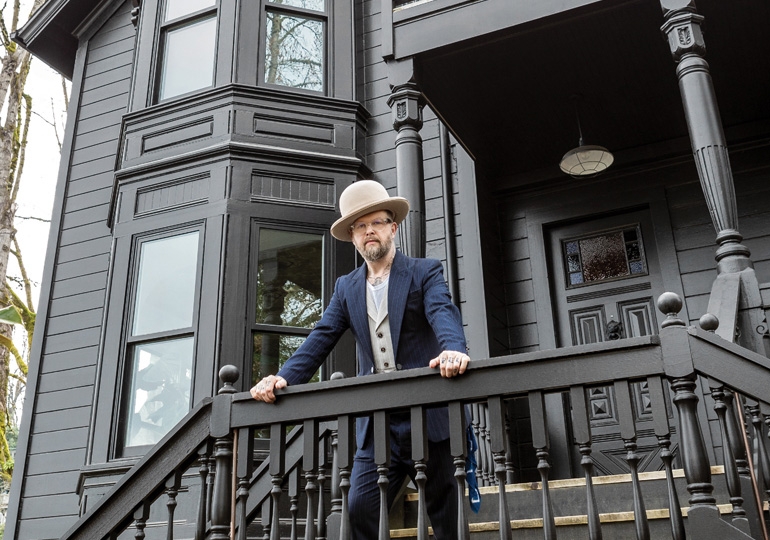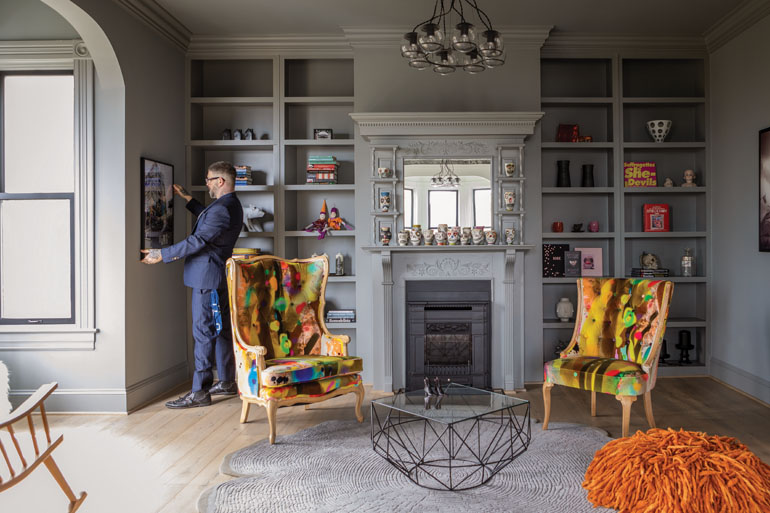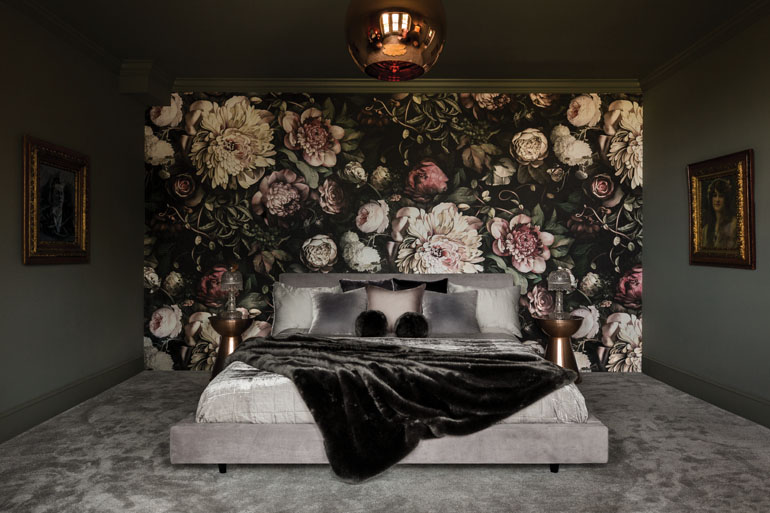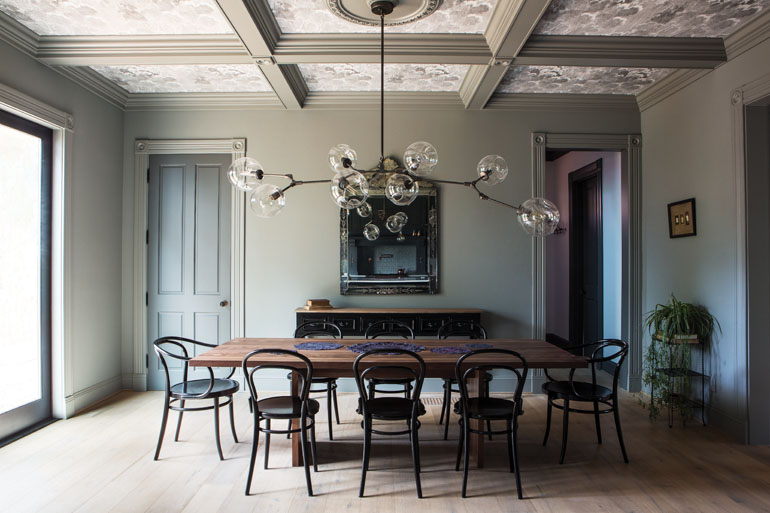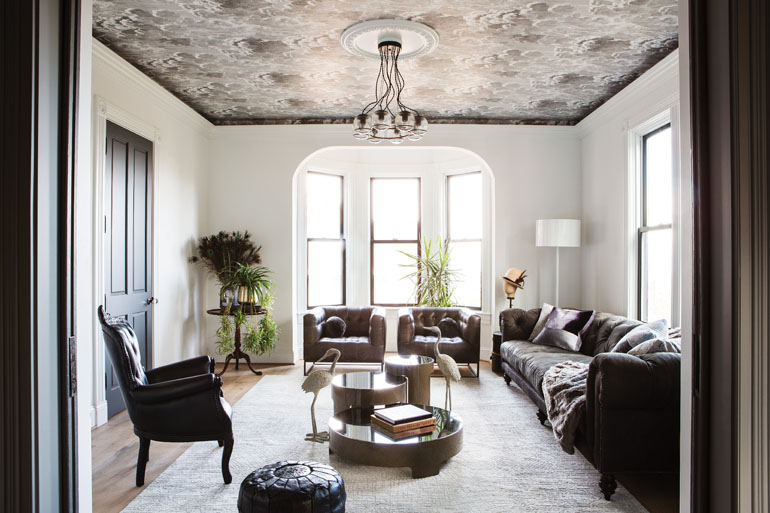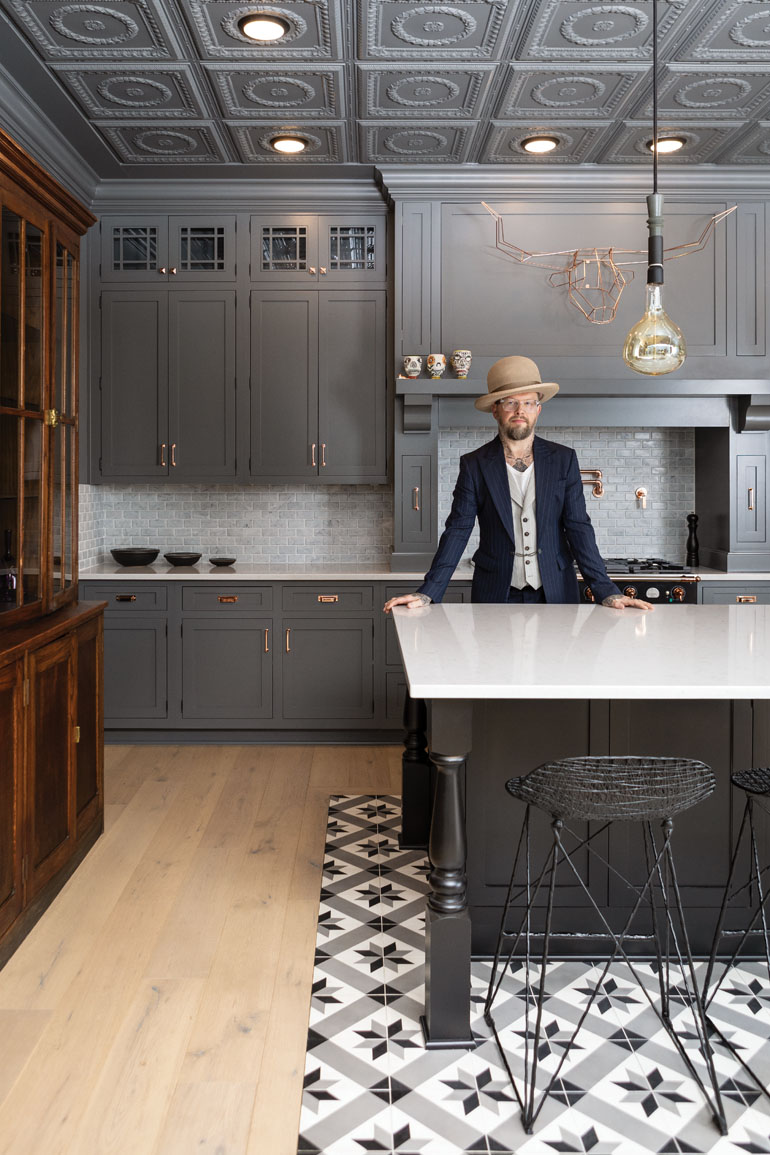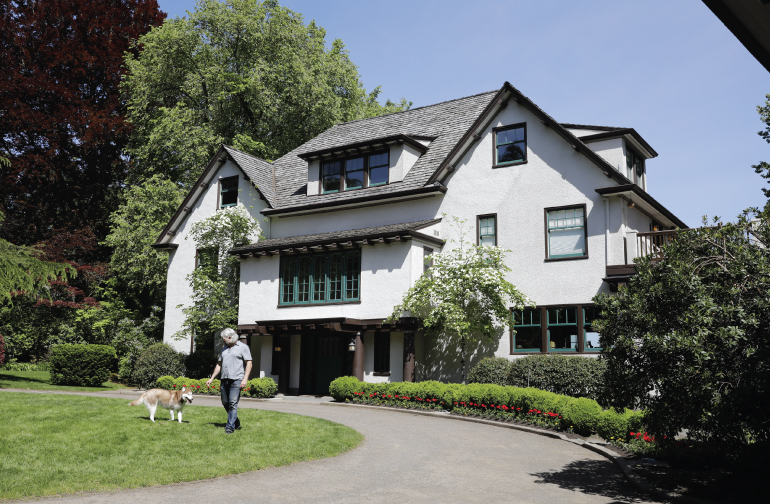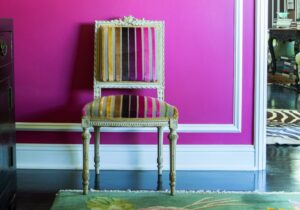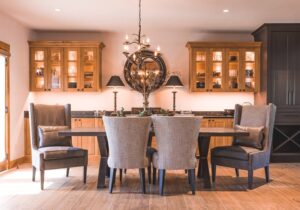Penny Black Interiors wants us to take more chances.
Photography by Christopher Dibble
In the 17 years he worked as a creative director driving innovation in apparel design at Nike, Stewart Horner never stopped collecting extra ideas and recording them in journals, sketchbooks and notes to himself. All the while, he was dreaming up an interior design firm defined less by its aesthetic than by its approach.
“There is a method to my madness,” Horner says. “I think I always knew what I wanted to achieve.”
All that documentation came to fruition in 2018, when he and his wife Lauren Reynolds launched Penny Black Interiors, a company fast earning a reputation for design-forward, memorable spaces that tweak history with a bold vision.
The company got its name from the nickname for the world’s first adhesive postage stamp, released in 1940 with a cameo-like portrait of Queen Victoria. It was a nod to Horner’s background—he was born in England and grew up there—but it also foretold the big splash he would make with his first interiors project as head of the new company, a spec home so singular and head-turning it made The Oregonian. The house was an 1896 Victorian on a hill in Portland Heights that was slated to be torn down, but it had all of the makings of a statement piece: Ornate woodwork, a characteristic Victorian vibe, a sprawling side veranda and above all, a spirit.
“I fully believe I can talk to spaces,” Horner says. “Houses tell me what they need.”
What this house desired, Horner says, was to survive. “It wanted a new life,” Horner said. “It was tired and rundown, and it just didn’t want to go.”
Inside, Horner says, something else was going on, and it was far from the creep show the home’s exteriors had suggested. Inside, he says, it felt really good. The home didn’t have a significant documented history, making it possible to create something new with it without running up against historic preservation authorities. So he grabbed it from the market and got to dreaming.
The Making of a Change Agent
Horner grew up in Sheffield, England the son of a builder and a psychologist, but was raised largely by his grandparents. His grandfather was an electrician, his grandmother a lady of many fineries who insisted on changing up the interiors in the home every three years. His childhood home was a “good mix of chintz” with traditional and modern furniture.
Horner completed his first interior redesigns in this space as a child, first changing his room to an explosion of red and green plaids, then moving more with the times (it was the 1980s) with a fully gray palette with 12-inch pink squares.
“I wasn’t particularly savvy at the time, I was just picking what I liked,” Horner says.
His family was entirely supportive of his forays into design. Later, after studying to become a fasion designer, he won a major interior design reality program on British television in the early aughts, before embarking on an international career at Nike and landing in Portland.
“I was so curious about things,” Horner said. “I always thought I could make everything better—eveything I owned, like my backpack. Now I do that for other people.”
Today his clients are people who are ready for him to lead them out of their comfort zone. Many of them are Nike and Apple executives, people who live and breathe design and who understand the ways intentional design can both delight them and support them in their work and home lives.
Those who do engage him should prepare to be dazzled and surprised. Horner always works the unexpected into his designs, a little something the homeowners don’t initially sign up for, but which often emerges as an eleventh-hour solution.
A staircase made of rainbow glass. A bold wallpaper on a master bedroom wall. Carpet that runs up the side of a space. Horner is always looking for ways to work with clients to travel with them toward something unprecedented.
“We are always asking ourselves: How can we look at this differently?” Horner says. “How can we put the most thought to make things new and a little bit off center?”
After schooling he won an interior design competition on BBC and became the show’s presenter for a spell, but soon took a job at Nike London, then Amsterdam, then the company’s Beaverton headquarters, where he had a 17-year run as an apparel designer.
Inspired By History
Since the launch of what is now known as the Penny Black House, the Victorian on the hill, Horner has worked with clients on projects vastly different in scope and style. A modern traditional suburban remodel in Beaverton, a midcentury modern home, a contemporary—the list spans architectural movements that have swept through Oregon. The range reflects someone less attached to a style than a way of looking at the world.
But even someone known for his bold, fearless designs comes across projects that test his mettle. Horner picked up one of his clients in a line at the Starbucks on NW 23rd Street. He was standing in line one day wearing his trademark custom-made bowler hat—one of 10 custom-made bowlers he owns and wears in the spirit of one of his design icons, Vivienne Westwood—when he began chatting with an older woman. He commented on the woman’s complicated coffee order and they struck up a conversation that ended up in a collaboration on a condo property on the Northwest waterfront.
He visited the woman’s home, a sprawling historic estate in the Dunthorpe neighborhood, and helped her begin a massive process of paring down her collections of objects and antiques as she downsized to the smaller space. So many of the pieces were great quality and very personal to the homeowner. He was able to create clever built-ins with custom millwork in the new space and incorporate the owner’s love of a personal sculpture collection, but the act of subtraction didn’t come easy.
“It was the most terrifying project I’ve worked on,” Horner says.
Q&A: Stewart Horner of Penny Black Interiors
What is the draw of a historic home?
For me, the draw of a historic home is the architecture. Being realistic, it may be a cliché, but they don’t make homes the way they used to. A house with historic significance has something special about it. Sometimes it is the home’s storied past that is fascinating unto itself. But from my point, I lean mostly on the architecture and environment for inspiration then create the design direction from getting to know and understand my clients, their hopes and dreams for the place. There isn’t always a great story attached to a house. Together we create a new part of its story. The narrative is really up to the owner to determine.
What are the challenges of doing the interiors for a Victorian home?
In the Pacific Northwest, it is always the condition of the property. Foundations are a massive challenge, as is the exterior woodwork, which is always 100+ years old. But people tend to look after and preserve the exterior woodwork, so it is often reasonably intact. The interiors are often lost, stripped out along the way. It gets quite expensive to do it right, so it can be cost-prohibitive. We can’t forget that Victorian style was created as a home for the wealthy, these homes were a status symbol.
Do you have a philosophy on what to keep and what to update?
With Victorians, I like to keep the integrity of the home—the detail in the millwork and trim work, the beautiful plaster accents. They are the heart and soul of a Victorian. I keep those as intact as possible. A lot of people want to be historically correct when they are working with a vintage home; they want to preserve it and take it back to exactly the way it was built. I’m less precious about that. I like to exaggerate detail playing with scale: We will widen or raise openings, use two layers of molding, open up spaces that are mostly closed off but people would think it had always been that way. Growing up in the United Kingdom, I lived in a house built in the 1700s—many homes and buildings are hundreds of years old and highly updated over the years. I’m OK to update it. I’m not a historian; people may not want to live in a museum. At Penny Black we prefer to revel in the design ideals of that era and update to fit in with modern home life.
Are there other periods you find compelling?
On a personal tip I love grand “hotel particulars” in Paris; large Italianate Victorian mansions in the U.S.A.; brutalist blocks of flats in London built as social housing developments, and I love a good A-frame. The list goes on, but really, the common thread is statement architecture. Postwar and midcentury is significant because it was the period that modernism was adopted into housing with its “form follows function” philosophies. Low-cost builds inspired by the early 1920s modernist movement dominated the new build growth. It was a different way of living, without decoration and without the superfluous—instead designed with function and simplicity at the heart. That principle has been the most significant influence on property development and home design for decades. But this past five years or so has seen a rise in the decorative arts influencing home design. In Europe a maximal revival has been evident and spearheaded by the likes of House of Hackney, a British lifestyle brand heavily influenced by the early Arts and Crafts movement, William Morris and the like. House of Hackney just open a flagship NYC store selling homewares, wall papers, fabrics and fashion with a unique Victorian vibe.
What’s your favorite rule to break when working with a historic home?
Rules are set by dictators. You tell me the rules and I’ll tell you how we break them. I believe in what I might call “era appropriation”—taking what is good from other points in time and using them in an appropriate way for today. I suppose that is defined as inspiration. I think historic preservation is essential where appropriate and I advocate for the registering of specific homes as “historically significant.” The Pittock Mansion is an example, and certainly I advocate for the prevention of demolition of period homes at all costs but some property is prevented from being updated at all inside or out which to me is just preventing a home from being what it was made to be. Arguably why should a homeowner be prevented from painting their home black if they so wish or from building an appropriate addition to that home? Sure people are caretakers of property not true owners but those caretakers are the people who live there. They are the people adding to the evolution of the home. It’s all history.



